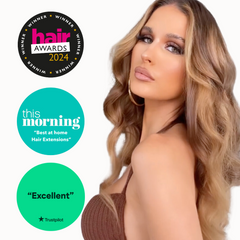
Unveiling the Truth about Hair Extensions Quality Standards
Share
Hair extensions have become a go-to solution for many seeking to enhance their natural locks, whether it's for added length, volume, or simply to experiment with different styles.
 However, navigating the world of hair extensions can be daunting, with numerous myths and misconceptions clouding the landscape. In this guide, we'll delve into the intricacies of hair extension quality, debunking common myths surrounding terms like "Russian/European hair" and the elusive hair extensions grading system.
However, navigating the world of hair extensions can be daunting, with numerous myths and misconceptions clouding the landscape. In this guide, we'll delve into the intricacies of hair extension quality, debunking common myths surrounding terms like "Russian/European hair" and the elusive hair extensions grading system.
Understanding Hair Quality: When it comes to human hair extensions, prices can differ vastly between suppliers, however quality is paramount to ensure longevity and value for money. Cheap hair extensions are not cheap if they need replacing every couple of months.
Debunking Hair Extension Myths:
- The "Russian/European Hair" Myth: One of the most pervasive myths in the hair extension industry is the labelling of extensions as "Russian", "Brazilian" or "European" hair. While these terms may evoke images of luxurious, high-quality strands, the reality is often quite different. In truth, many extensions labeled as such may not actually originate from these regions but are rather marketing tactics designed to appeal to consumers' perceptions of quality.
- Is single donor hair actually from one person?: Touted as top of the quality scale,"Single donor virgin" hair is often described as coming from just one person, however, the raw material collection and manufacturing process of hair extensions makes this highly unlikely and without easy access to forensic scientific equipment, a claim highly unlikely to be able to substantiate. The term 'virgin' is slightly easier to substantiate as it generally refers to the fact the hair that has never been chemically treated.
- The Grading Conundrum: Another common source of confusion for consumers is the hair grading system. With labels like AAAA, 7A, or 8A floating around, it's easy to assume that these grades indicate superior quality. However, the truth is far more nuanced. The grading system lacks standardisation, with different suppliers using varying criteria to assign grades. As a result, relying solely on grades can be misleading and may not accurately reflect the true quality of the hair.
How to Assess Hair Extensions Quality:
- Texture and Feel: When evaluating hair extensions, pay close attention to the texture and feel of the hair. High-quality extensions should feel soft, smooth, and natural to the touch. Run your fingers through the strands and observe how they move and behave, ensuring they mimic the characteristics of your own hair.
- Colour and Consistency: A key indicator of quality is the colour and consistency of the extensions. Look for extensions that closely match your natural hair colour and exhibit uniformity in both colour and texture throughout the bundle. Discrepancies in colour or texture may signal lower quality or inconsistencies in the manufacturing process.
- Durability and Longevity: Quality hair extensions should be durable and long-lasting, able to withstand regular styling and maintenance without losing their integrity. Check the thickness and strength of the strands, paying attention to any signs of shedding or breakage. Investing in durable extensions and an effective maintenance regime will ensure they remain beautiful and wearable for an extended period.
Expert Tips for Purchasing the Best Hair Extensions:
- Research and Reviews: Before making a purchase, take the time to research different suppliers and read reviews from other customers. Look for feedback on the quality, durability and customer service provided by each supplier to make an informed decision.
- Consultation with Professionals: When in doubt, seek guidance from hairstylists or extension specialists. They can offer valuable insights and recommendations based on your specific hair type, preferences and budget. During consultations, don't hesitate to ask questions and voice any concerns to ensure you find the perfect extensions for your needs.
- There are ways in which to reduce the cost of a full head of extensions when on a budget without compromising on using a quality, brand:
- Avoid super long lengths - customers pay a premium for longer lengths such as 20 inches upwards. It's easy to appreciate why this is, when you consider the fact that they have taken anything between 7-10 years to 'manufacture' on the hair donors head.
- Mix lengths to stretch your budget further - purchase shorter (and cheaper) lengths to fit lower down your head and save the more expensive longer lengths to be fitted further up you head where you need to cover more length.
- Start with a small number of packs initially and add an extra pack at the next couple of refits, this way you can spread the cost on your journey to more volume.
- Sign up to brand emails to be the first to know when the company is running discounts and sales and always check websites out for sale pages.
Hair extensions offer a versatile and convenient way to transform your look, but understanding quality is key to achieving the best results. By debunking myths and focusing on factors like texture, colour, and durability, you can make informed decisions when purchasing extensions. Remember, it's not about labels or grades – it's about finding extensions that look and feel like a natural extension of yourself.
